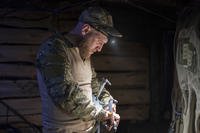The U.S. Naval Research Laboratory has been granted the first U.S. patent for a method of simultaneously extracting carbon dioxide and hydrogen from seawater – a single process that will provide all the materials necessary to produce synthetic hydrocarbon fuels.
Synthetic fuel production translates into logistical and operational advantages by reducing dependency on future in-theater fossil fuel availability and reducing the vulnerabilities that come with unprotected fuel delivery at sea.
“A ship's ability to produce a significant fraction of the battle group's fuel for operations at sea could reduce the mean time between refueling, and increase the operational flexibility and time on station,” said Cmdr. Felice DiMascio, one five co-authors and inventors of the method.
DiMascio said that reducing the logistics tail on fuel delivery and potentially increasing the Navy's energy security and independence, all with minimal impact on the environment, were key factors in the developing the Electrolytic Cation Exchange Module, or E-CEM.

The method should give the Navy a capability to develop synthetic fuel stock for the production of LNG, CNG, F-76, and JP-5 while at sea or in remote locations.
The E-CEM, located at NRL's Marine Corrosion Facility, Key West, Florida, has successfully demonstrated proof-of-concept simultaneous recovering from seawater CO2 and H2 that are catalytically converted to hydrocarbons in a second additional, synthetic step.
A second-generation, large-scale E-CEM research prototype is still to be demonstrated at the Key West facility. The size and scale of the E-CEM is the next step towards integrating and commercializing these systems, the Lab said in a statement.
Others named on U.S. Patent and Trademark Office Patent #9303323 to the lab’s Material Science and Technology Division are M. Kathleen Lewis of the Office of Naval Research, and Dennis Hardy, Heather Willauer and Frederick Williams, all of the Naval Research Laboratory.









